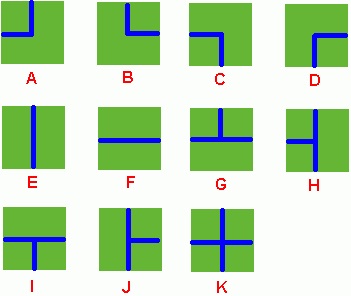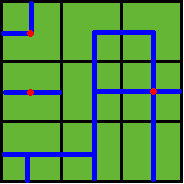HDOJ1198(Farm Irrigation)
Farm Irrigation
Time Limit: 2000/1000 MS (Java/Others) Memory Limit: 65536/32768 K (Java/Others)Total Submission(s): 553 Accepted Submission(s): 256
Problem Description
Benny has a spacious farm land to irrigate. The farm land is a rectangle, and is divided into a lot of samll squares. Water pipes are placed in these squares. Different square has a different type of pipe. There are 11 types of pipes, which is marked from A to K, as Figure 1 shows.

Figure 1
Benny has a map of his farm, which is an array of marks denoting the distribution of water pipes over the whole farm. For example, if he has a map
ADC
FJK
IHE
then the water pipes are distributed like

Figure 2
Several wellsprings are found in the center of some squares, so water can flow along the pipes from one square to another. If water flow crosses one square, the whole farm land in this square is irrigated and will have a good harvest in autumn.
Now Benny wants to know at least how many wellsprings should be found to have the whole farm land irrigated. Can you help him?
Note: In the above example, at least 3 wellsprings are needed, as those red points in Figure 2 show.

Benny has a map of his farm, which is an array of marks denoting the distribution of water pipes over the whole farm. For example, if he has a map
ADC
FJK
IHE
then the water pipes are distributed like

Several wellsprings are found in the center of some squares, so water can flow along the pipes from one square to another. If water flow crosses one square, the whole farm land in this square is irrigated and will have a good harvest in autumn.
Now Benny wants to know at least how many wellsprings should be found to have the whole farm land irrigated. Can you help him?
Note: In the above example, at least 3 wellsprings are needed, as those red points in Figure 2 show.
Input
There are several test cases! In each test case, the first line contains 2 integers M and N, then M lines follow. In each of these lines, there are N characters, in the range of 'A' to 'K', denoting the type of water pipe over the corresponding square. A negative M or N denotes the end of input, else you can assume 1 <= M, N <= 50.
Output
For each test case, output in one line the least number of wellsprings needed.
Sample Input
2 2 DK HF 3 3 ADC FJK IHE -1 -1
Sample Output
2 3
 //Accepted 1198 15MS 304K 1768 B C++
//Accepted 1198 15MS 304K 1768 B C++  #include <iostream>
#include <iostream> #include <set>
#include <set> using namespace std;
using namespace std;
 const int N = 52;
const int N = 52;
 typedef struct
typedef struct {
{ int parent;
int parent; int height;
int height; }node;
}node;
 int m, n;
int m, n; char graph[N][N];
char graph[N][N]; node UFSet[N * N];
node UFSet[N * N];
 bool con[][4] = {{1, 0, 1, 0}, {1, 0, 0, 1}, {0, 1, 1, 0},
bool con[][4] = {{1, 0, 1, 0}, {1, 0, 0, 1}, {0, 1, 1, 0}, {0, 1, 0, 1}, {1, 1, 0, 0},{0, 0, 1,1},{1, 0, 1, 1}, {1, 1, 1, 0},
{0, 1, 0, 1}, {1, 1, 0, 0},{0, 0, 1,1},{1, 0, 1, 1}, {1, 1, 1, 0}, {0, 1, 1, 1},{1, 1, 0, 1}, {1, 1, 1, 1}};
{0, 1, 1, 1},{1, 1, 0, 1}, {1, 1, 1, 1}};
 void init(int cn)
void init(int cn) {
{ for(int i = 0; i <= cn; i++)
for(int i = 0; i <= cn; i++) {
{ UFSet[i].parent = i;
UFSet[i].parent = i; UFSet[i].height = 1;
UFSet[i].height = 1; }
} }
}
 int find(int x)
int find(int x) {
{ while(x != UFSet[x].parent)
while(x != UFSet[x].parent) x = UFSet[x].parent;
x = UFSet[x].parent; return x;
return x; }
}
 void merge(int x, int y)
void merge(int x, int y) {
{ if(x == y)
if(x == y) return ;
return ;
 if(UFSet[x].height == UFSet[y].height)
if(UFSet[x].height == UFSet[y].height) {
{ UFSet[y].parent = x;
UFSet[y].parent = x; UFSet[x].height++;
UFSet[x].height++; }
} else if(UFSet[x].height > UFSet[y].height)
else if(UFSet[x].height > UFSet[y].height) UFSet[y].parent = x;
UFSet[y].parent = x; else
else UFSet[x].parent = y;
UFSet[x].parent = y; }
}
 bool isBound(int x, int y)
bool isBound(int x, int y) {
{ if(x < 0 || y < 0)
if(x < 0 || y < 0) return false;
return false; if(x >= m || y >= n)
if(x >= m || y >= n) return false;
return false; return true;
return true; }
}

 void solve()
void solve() {
{ int i, j;
int i, j; int a, b;
int a, b; init(n * m);
init(n * m);
 for(i = 0; i < m; i++)
for(i = 0; i < m; i++) for(j = 0; j < n; j++)
for(j = 0; j < n; j++) {
{ if(isBound(i - 1, j))
if(isBound(i - 1, j)) if(con[graph[i][j] - 'A'][0] && con[graph[i - 1][j] - 'A'][1])
if(con[graph[i][j] - 'A'][0] && con[graph[i - 1][j] - 'A'][1]) {//判断(i, j)和其上方点(i - 1, j)是否连通
{//判断(i, j)和其上方点(i - 1, j)是否连通 a = (i - 1) * n + j;
a = (i - 1) * n + j; b = i * n + j;
b = i * n + j; a = find(a); b= find(b);
a = find(a); b= find(b); merge(a, b);
merge(a, b); }
} if(isBound(i, j - 1))
if(isBound(i, j - 1)) if(con[graph[i][j] - 'A'][2] && con[graph[i][j - 1] - 'A'][3])
if(con[graph[i][j] - 'A'][2] && con[graph[i][j - 1] - 'A'][3]) {//判断(i, j)和其左方点(i, j - 1)是否连通
{//判断(i, j)和其左方点(i, j - 1)是否连通 a = i * n + j - 1;
a = i * n + j - 1; b = i * n + j;
b = i * n + j; a = find(a); b= find(b);
a = find(a); b= find(b); merge(a, b);
merge(a, b); }
} }
} set<int> S;
set<int> S; for(i = 0; i < n * m; i++)
for(i = 0; i < n * m; i++) S.insert(find(i));
S.insert(find(i));
 cout<<S.size()<<endl;
cout<<S.size()<<endl; }
} int main()
int main() {
{ while(scanf("%d%d", &m, &n) != EOF)
while(scanf("%d%d", &m, &n) != EOF) {
{ if(m < 0 || n < 0) break;
if(m < 0 || n < 0) break; getchar();
getchar(); for(int i = 0;i < m; i++)
for(int i = 0;i < m; i++) scanf("%s", graph + i);
scanf("%s", graph + i);
 solve();
solve(); }
} return 0;
return 0; }
}





